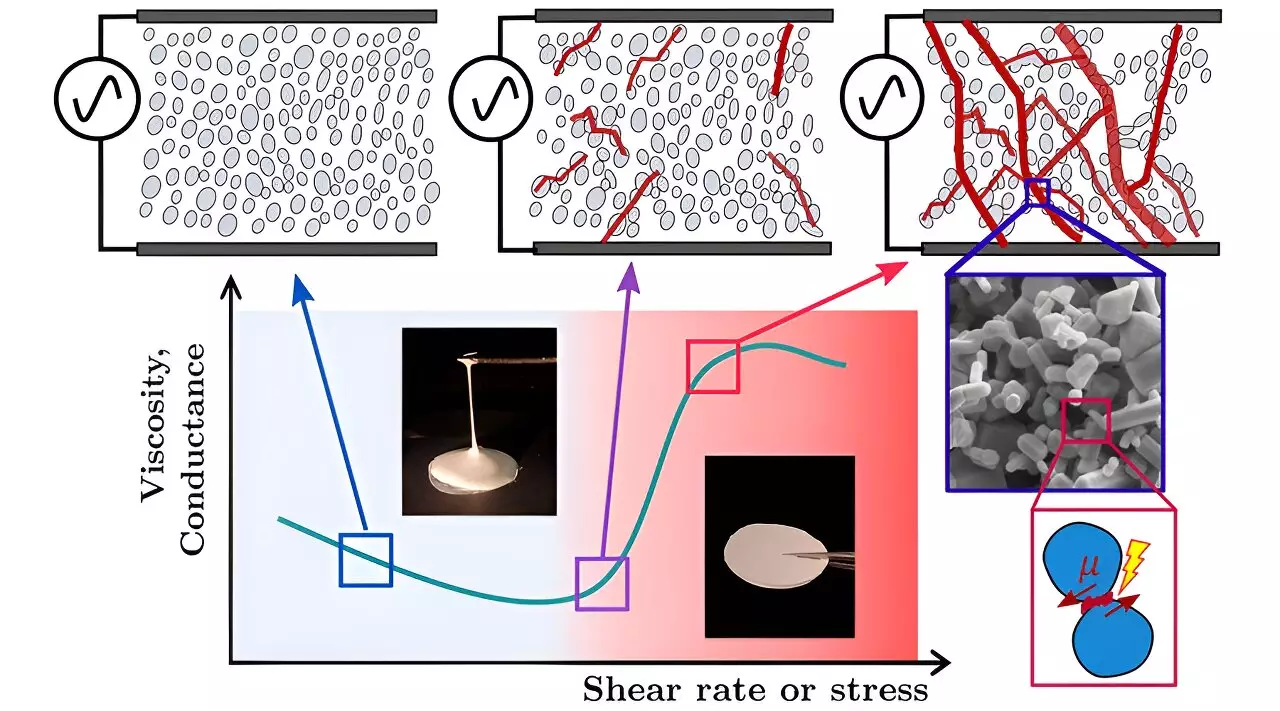It’s mesmerizing how a mixture of cornstarch and water can create a substance that behaves like neither a liquid nor a solid. Known as oobleck, this non-Newtonian fluid flows like a liquid when left undisturbed but turns firm when pressure is applied. Non-Newtonian fluids, including Silly Putty, quicksand, paint, and yogurt, have perplexed scientists for years, as their properties change under stress or pressure. However, a breakthrough study conducted by researchers at the University of Chicago’s Pritzker School of Molecular Engineering (PME) has shed light on the fundamental physics governing these peculiar fluids. By utilizing piezoelectric nanoparticles that respond to pressure, the team has uncovered the critical role of friction in the transformation of non-Newtonian fluids. This discovery not only unravels longstanding mysteries surrounding these materials but also opens doors for the development of new non-Newtonian fluids with practical applications.
The research team at PME delved into exploring the physical origins of non-Newtonian fluids by employing piezoelectric nanoparticles. These nanoparticles possess the unique ability to change in response to pressure. By harnessing this property, scientists embarked on investigating why non-Newtonian fluids transition from a fluid state to a more solid structure. The paper, published in Proceedings of the National Academy of Sciences, highlights the significance of particle friction in this shift. Stuart Rowan, the Barry L. MacLean Professor of Molecular Engineering and co-senior author of the study, expresses enthusiasm about the findings and their implications for material design. He suggests that this breakthrough can pave the way for non-clumping paint, moldable liquids, and protective gear that stiffens on impact.
A central characteristic of non-Newtonian fluids is their dramatic change in viscosity, or thickness, under stress. Contrary to conventional fluids that tend to thin under pressure, non-Newtonian fluids can exhibit both thickening and thinning behavior. For instance, shaking a ketchup bottle makes it pour more easily, while yogurt and toothpaste maintain their shape in containers and become more liquid-like when subjected to force. Oobleck, on the other hand, behaves inversely, feeling solid when manipulated and transforming into a pool when left alone. Scientists have proposed various hypotheses to explain why non-Newtonian fluids behave this way, but proving these hypotheses has proven challenging.
One of the major obstacles in understanding concentrated particle suspensions, such as oobleck, lies in visualizing their nanoscale structure. The particles in these fluids are densely packed together, making it nearly impossible to image their precise arrangement. To overcome this hurdle, postdoctoral scholar Hojin Kim, the first author of the study, collaborated with Rowan, Aaron Esser-Kahn, a professor in the PME specializing in piezochemistry, and Heinrich Jaeger, the Sewell Avery Distinguished Service Professor of Physics. Together, they developed a groundbreaking technique that measures the change in electrical conductance based on the applied shear force. By suspending the piezoelectric nanoparticles in a liquid at a similar concentration to oobleck, the researchers were able to observe the changes in viscosity and electrical signals as the shear force was applied.
The Role of Friction
The team’s experiments revealed a crucial discovery – the friction between particles plays a pivotal role in the transition of non-Newtonian fluids. Kim explains that when the friction reaches a certain threshold in a concentrated particle solution, the viscosity of the fluid suddenly increases. Understanding the underlying physical forces at play in these solutions is a significant step towards designing new non-Newtonian fluids in the laboratory. With further research, these engineered materials could exhibit customizable properties, allowing scientists to control their viscosity under stress. This has the potential to reduce clumping and clogging in substances like paint and concrete or enable deliberate hardening when desired.
Non-Newtonian fluids are ubiquitous, making the impact of this research far-reaching. Kim notes that while this study may seem fundamental, its implications extend to numerous applications. The Pritzker Molecular Engineering and UChicago researchers envision harnessing the stress-induced piezoelectric activity of their nanoparticle suspensions to design adaptive and responsive materials. For example, these materials could become stiffer under mechanical force, leading to innovations in protective gear. By determining the ideal combination of solvents, particles, and shear conditions, scientists aim to unlock the full potential of non-Newtonian fluids.
The study conducted by the University of Chicago’s PME sheds light on the elusive physics behind non-Newtonian fluids. The utilization of piezoelectric nanoparticles has unraveled the role of friction in the transition from fluid to solid-like behavior. This breakthrough provides a roadmap for developing new non-Newtonian fluids with practical applications, such as paint that doesn’t clump, moldable liquids, and impact-responsive materials. The far-reaching implications of this research offer a glimpse into a future where scientists can manipulate the viscosity of substances through stress, revolutionizing various industries and opening doors to innovative materials.


Leave a Reply